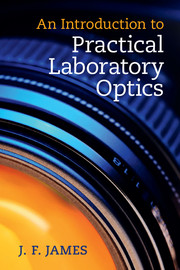Book contents
- Frontmatter
- Contents
- Preface
- 1 Introduction: centred optical systems
- 2 Telescopes and binoculars
- 3 Eyepieces, eyes and colour
- 4 Cameras and camera lenses
- 5 The scientific CCD camera
- 6 Spectrometry
- 7 Interferometers and their uses
- 8 Electro-optical effects and their practical uses
- 9 Microscopes and projectors
- 10 Siderostats and coelostats
- 11 The detection and measurement of radiation
- 12 Practicalities
- Appendix A Gaussian optics
- Appendix B Optical aberrations
- Appendix C A brief introduction to Fourier optics
- Further reading
- Index
8 - Electro-optical effects and their practical uses
Published online by Cambridge University Press: 05 October 2014
- Frontmatter
- Contents
- Preface
- 1 Introduction: centred optical systems
- 2 Telescopes and binoculars
- 3 Eyepieces, eyes and colour
- 4 Cameras and camera lenses
- 5 The scientific CCD camera
- 6 Spectrometry
- 7 Interferometers and their uses
- 8 Electro-optical effects and their practical uses
- 9 Microscopes and projectors
- 10 Siderostats and coelostats
- 11 The detection and measurement of radiation
- 12 Practicalities
- Appendix A Gaussian optics
- Appendix B Optical aberrations
- Appendix C A brief introduction to Fourier optics
- Further reading
- Index
Summary
Introduction: polarized light
James Clerk Maxwell (1831–1879) discovered the first unified field theory when in 1865 he showed, drawing on Faraday's experiments, the Biot–Savart law and other results, that interacting electric and magnetic fields and forces could be described by the same set of equations. Oliver Heaviside (1850–1925) reduced the twenty quaternion equations of Maxwell's theory to the four vector equations that ordinary mortals could understand. Maxwell showed that a wave equation could be deduced and that the consequent electromagnetic field propagates in a direction perpendicular to its electric and magnetic field vectors, and at a velocity which could be calculated from two quantities (permittivity and susceptibility) measurable in separate laboratory experiments. The resultant computed velocity was very close indeed to the experimentally measured speed of light. It was an easy conjecture then, that light was electromagnetic radiation. It was a further logical extension to predict radio waves, later confirmed by David Hughes' and Heinrich Hertz's spark-gap experiments.
The mutually perpendicular electric and magnetic field vectors oscillate in amplitude at about 5 × 1014 Hz for red light. If the direction of propagation is the positive z-direction, then the electric and magnetic vectors lie in the x−y plane. The light is said to be plane polarized if the angle the electric vector makes with the x-axis is constant in time.
Information
- Type
- Chapter
- Information
- An Introduction to Practical Laboratory Optics , pp. 104 - 115Publisher: Cambridge University PressPrint publication year: 2014
